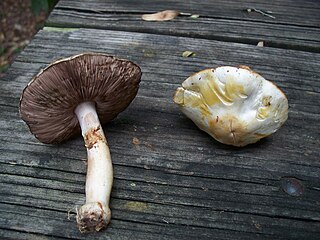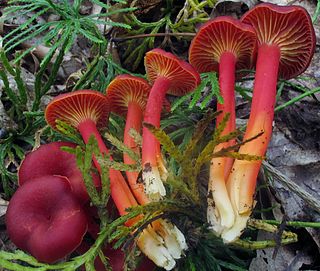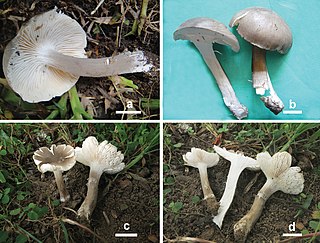
The Boletaceae are a family of mushroom-forming fungi, primarily characterised by small pores on the spore-bearing hymenial surface, instead of gills as are found in most agarics. Nearly as widely distributed as the agarics, the family is renowned for hosting some prime edible species highly sought after by mushroom hunters worldwide, such as the cep or king bolete . A number of rare or threatened species are also present in the family, that have become the focus of increasing conservation concerns. As a whole, the typical members of the family are commonly known as boletes.

Hydnum repandum, commonly known as the sweet tooth, pig's trotter, wood hedgehog or hedgehog mushroom, is a basidiomycete fungus of the family Hydnaceae. First described by Carl Linnaeus in 1753, it is the type species of the genus Hydnum. The fungus produces fruit bodies (mushrooms) that are characterized by their spore-bearing structures—in the form of spines rather than gills—which hang down from the underside of the cap. The cap is dry, colored yellow to light orange to brown, and often develops an irregular shape, especially when it has grown closely crowded with adjacent fruit bodies. The mushroom tissue is white with a pleasant odor and a spicy or bitter taste. All parts of the mushroom stain orange with age or when bruised.

Collybia nuda, commonly known as the blewit or wood blewit and previously described as Lepista nuda and Clitocybe nuda, is an edible mushroom native to Europe and North America. Described by Pierre Bulliard in 1790, it was also known as Tricholoma nudum for many years. It is found in both coniferous and deciduous woodlands. It is a fairly distinctive mushroom that is widely eaten. It has been cultivated in Britain, the Netherlands and France. This species was reassigned to the genus Collybia in 2023.

Hygrophorus is a genus of agarics in the family Hygrophoraceae. Called "woodwaxes" in the UK or "waxy caps" in North America, basidiocarps are typically fleshy, often with slimy caps and lamellae that are broadly attached to decurrent. All species are ground-dwelling and ectomycorrhizal and are typically found in woodland. Around 100 species are recognized worldwide. Fruit bodies of several species are considered edible and are sometimes offered for sale in local markets.

Tylopilus is a genus of over 100 species of mycorrhizal bolete fungi separated from Boletus. Its best known member is the bitter bolete, the only species found in Europe. More species are found in North America, such as the edible species T. alboater. Australia is another continent where many species are found. All members of the genus form mycorrhizal relationships with trees. Members of the genus are distinguished by their pinkish pore surfaces.

Macrolepiota is a genus of white spored, gilled mushrooms of the family Agaricaceae. The best-known member is the parasol mushroom (M. procera). The widespread genus contains about 40 species.

Porpolomopsis lewelliniae, commonly known as the mauve splitting wax-cap, is a gilled fungus of the waxcap family found in wet forests of eastern Australia and New Zealand. The small mauve- or lilac-coloured mushrooms are fairly common and appear in moss or leaf litter on the forest floor in autumn, and are biotrophic. The key distinguishing feature is the splitting of the cap dividing down the middle of the individual gills.

Agaricus abruptibulbus is a species of mushroom in the genus Agaricus. It is commonly known as the abruptly-bulbous agaricus or the flat-bulb mushroom. First described by the mycologist Charles Horton Peck, this bulbous-stemmed edible species smells slightly of anise or bitter almond, and turns yellow when bruised or cut. The mushroom is medium-sized, with a white, yellow-staining cap on a slender stipe that has a wide, flat bulb on the base.

Polyozellus is a fungal genus in the family Thelephoraceae, a grouping of mushrooms known collectively as the leathery earthfans. Previously considered a monotypic genus, it now contains the Polyozellus multiplex species complex. The genus name is derived from the Greek poly meaning many, and oz, meaning branch. It is commonly known as the blue chanterelle, the clustered blue chanterelle, or, in Alaska, the black chanterelle. The distinctive fruit body of this species comprises blue- to purple-colored clusters of vase- or spoon-shaped caps with veiny wrinkles on the undersurface that run down the length of the stem.

Amanita ceciliae, commonly called snakeskin grisette, strangulated amanita, and the Cecilia's ringless amanita, is a basidiomycete fungus in the genus Amanita. First described in 1854 by Miles Joseph Berkeley and Christopher Edmund Broome, it was given its current name by Cornelis Bas in 1984. It is characterized by bearing a large fruit body with a brown cap 5–12 cm (2.0–4.7 in) across. The cap has charcoal-grey patches, which are easily removable. The stipe is 7–18 cm (2.8–7.1 in) long, white in colour, and there is no ring on it. It is slightly tapered to the top and has irregular cottony bands girdling the base. The universal veil is grey. Spores are white, spherical in shape, non-amyloid, and measure 10.2–11.7 micrometres. The mushrooms are considered edible, but field guides typically advise caution in selecting them for consumption, due to risks of confusion with similar toxic species. A. ceciliae is found in woods throughout Europe and North America, where it fruits during summer and autumn.

Hygrophorus marzuolus, commonly known as the March mushroom, is a species of fungus in the family Hygrophoraceae. It is known from Asia, Europe, and North America, where it grows on the ground in mixed forests at high elevations.

Hygrophorus purpurascens, commonly known as the purple-red waxy cap, is a species of agaric fungus in the family Hygrophoraceae. Its cap has a pink background color with streaks of purplish red overlaid, and mature gills have red spots.

Lepiota cristata, commonly known as the stinking dapperling, brown-eyed parasol, or the stinking parasol, is an agaric and possibly poisonous mushroom in the family Agaricaceae. A common and widespread species—one of the most widespread fungi in the genus Lepiota—it has been reported from Europe, northern Asia, North America, and New Zealand. It fruits on the ground in disturbed areas, such as lawns, path and road edges, parks, and gardens. The species produces fruit bodies characterized by the flat, reddish-brown concentric scales on the caps, and an unpleasant odour resembling burnt rubber. Similar Lepiota species can sometimes be distinguished from L. cristata by differences in cap colour, stipe structure, or odour, although some species can only be reliably distinguished through the use of microscopy.

Lactifluus clarkeae, formerly known as Lactarius clarkeae, is a species of mushroom-forming fungus in the family Russulaceae. It is found in Australia and New Zealand in mycorrhizal association with species of Nothofagus and the family Myrtaceae.

Hygrocybe appalachianensis, commonly known as the Appalachian waxy cap, is a gilled fungus of the waxcap family. It is found in the eastern United States, where it fruits singly, in groups, or clusters on the ground in deciduous and mixed forests. The species, described in 1963 from collections made in the Appalachian Mountains, was originally classified in the related genus Hygrophorus. It was transferred to Hygrocybe in 1998, in which it has been proposed as the type species of section Pseudofirmae.

Cuphophyllus canescens is a species of agaric in the family Hygrophoraceae, known from North America. In its wide sense it has been assessed as globally "vulnerable" on the IUCN Red List of Threatened Species.

Cantharocybe virosa is a member of the fungal family Hygrophoraceae that has been identified in India, Bangladesh and Thailand. It is an ectomycorrhizal fungus that is toxic for consumption and has no know uses in agriculture, horticulture or medicine. C. virosa is a gray to gray-brown fungus with white to yellowish-white gills that can be found in soil or on mud walls near Cocos nucifera.

Amanita orientigemmata, is a species of agaric fungus in the family Amanitaceae native to northeastern, northwestern and southern China, India and Japan, first described by Zhu L. Yang & Yoshimichi Doi in 1999.

Zhuliangomyces illinitus is a mushroom-forming fungus species of genus Zhuliangomyces in the family Amanitaceae in the order Agaricales. It has been known most recently as Limacella illinita. Also known previously as Agaricus illinitus and Mastocephalus illinitus. This fungus is known for its distinctive slimy cap. Z. illinitus is commonly known as the dripping slimecap or the overflowing slimy stem.

Lichenomphalia velutina is a species of basidiolichen in the family Hygrophoraceae. It was first formally described in 1886 by the French mycologist Lucien Quélet, who classified it in the genus Omphalia. It was transferred to its current genus, Lichenomphalia, in 2002. Known primarily as having a European and North American distribution, the fungus was recorded from China for the first time in 2018. Chinese collections occur at elevations greater than 3,000 m (9,800 ft), while those in Europe tend to be at elevations under 1,500 m (4,900 ft). Lichenomphalia velutina also occurs in Greenland. It grows on soil and on moss.



















